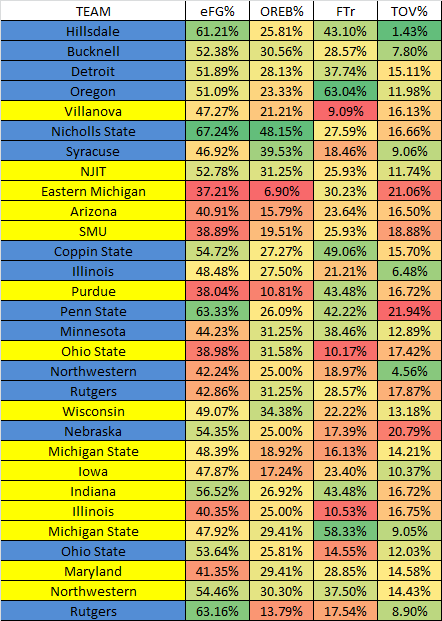"So That Happened...": The Regular Season In Basketball
With the Big Ten Tournament now looming and a bid in the NIT (yes, the NIT) rather dependent on at least a decent showing in Chicago, I thought we might reflect on some of the statistical high and lows throughout the season, focusing mainly on the tempo-free stats. However, I can definitely post other metrics if you would like. Sticking with these simply keeps the size of this down.
So, let’s take a look at the four factors throughout the course of 30 games and insert the magic of conditional formatting:
It’s best to start at the top and scroll down – wins are blue, losses are yellow in the “Team” column. It won’t tell you a story that you don’t already know, but it is interesting to see these numbers lined up with those wins and losses. Indeed, everything is going reasonably well even up to the end of the NJIT, as embarrassing as that loss was. We definitely played well enough to win that game but…well, anyway, there was the Eastern Michigan game. Simple, right?
Nope.
Take note of a few things – the EMU game was our worst performance for effective field goal percentage and offensive rebounding percentage, as well as the second worst for turnover rate (the worst performance on that metric is a game we actually won, oddly enough). From there, what follows is a rather rough stretch to end the non-conference schedule highlighted by some high turnover games by Michigan standards and rough shooting performances.
Here’s where the numbers get funny, at least in my opinion. Those first seven games of the conference schedule, where we went 5-2, our eFG% averaged 45.45%, but in the next 11 games – a stretch where Michigan was an inglorious 3-8, our eFG was 50.64%. That represented substantial improvement, if you look at individual games, but then pair that up with who you were playing and you get the idea. The other three metric were otherwise fairly stable throughout with some spot great / not-so-great performances here and there.
Below are some summary averages and some measures of variation:
|
CONFERENCE AVERAGES |
MICHIGAN |
OPPONENT |
MARGIN |
|
Field Goal % |
41.57% |
45.60% |
-4.03% |
|
Three Point % |
35.69% |
33.30% |
2.39% |
|
Effective FG% |
48.62% |
51.52% |
-2.90% |
|
Free Throw % |
79.25% |
68.62% |
10.62% |
|
Off. Rebound % |
25.54% |
33.25% |
-7.71% |
|
Def. Rebound % |
66.75% |
74.46% |
-7.71% |
|
Assist / Turnover Ratio |
1.360 |
1.295 |
0.065 |
|
True Shooting % |
52.81% |
54.40% |
-1.59% |
|
Free Throw Rate |
27.39% |
28.87% |
-1.49% |
|
Possessions |
59.84 |
59.86 |
-0.01 |
|
Points / Possession |
1.04 |
1.09 |
-0.05 |
|
Turnover % |
13.83% |
15.27% |
-1.44% |
Admittedly, the turnover number should have the opposite sign, but you get the idea there for the conference. Here’s the non-conference:
|
NON-CONFERENCE AVERAGES |
MICHIGAN |
OPPONENT |
MARGIN |
|
Field Goal % |
42.55% |
44.55% |
-2.00% |
|
Three Point % |
36.98% |
36.83% |
0.15% |
|
Effective FG% |
50.21% |
51.40% |
-1.19% |
|
Free Throw % |
71.12% |
74.88% |
-3.76% |
|
Off. Rebound % |
26.45% |
25.80% |
0.65% |
|
Def. Rebound % |
74.20% |
73.55% |
0.65% |
|
Assist / Turnover Ratio |
1.62 |
0.93 |
0.682 |
|
True Shooting % |
53.96% |
54.07% |
-0.11% |
|
Free Throw Rate |
31.86% |
23.17% |
8.70% |
|
Possessions |
62.33 |
63.88 |
-1.55 |
|
Points / Possession |
1.09 |
0.98 |
0.11 |
|
Turnover % |
13.50% |
20.16% |
-6.66% |
Those actually look much better, relatively speaking, but they should since we did markedly better in some of these games, at least statistically.
You’ll see a visualization of the conference numbers in a bit (the tempo-free ones), but here are some averages with their accompanying standard deviations so you grasp the variation of play this season.
|
OVERALL AVERAGE / VARIATION |
AVERAGE |
STD. DEV. |
|
Field Goal % |
41.96% |
6.62% |
|
Three Point % |
36.21% |
10.79% |
|
Effective FG% |
49.26% |
7.90% |
|
Free Throw % |
76.00% |
13.22% |
|
Off. Rebound % |
25.90% |
8.12% |
|
Def. Rebound % |
69.73% |
9.73% |
|
Assist / Turnover Ratio |
1.46 |
0.94 |
|
True Shooting % |
53.27% |
7.88% |
|
Free Throw Rate |
29.18% |
13.65% |
|
Possessions |
60.84 |
4.04 |
|
Points / Possession |
1.06 |
0.18 |
|
Turnover % |
13.70% |
4.82% |
|
BIG TEN AVERAGE / VARIATION |
AVERAGE |
STD. DEV. |
|
Field Goal % |
41.57% |
6.31% |
|
Three Point % |
35.69% |
9.69% |
|
Effective FG% |
48.62% |
7.46% |
|
Free Throw % |
79.25% |
12.95% |
|
Off. Rebound % |
25.54% |
6.27% |
|
Def. Rebound % |
66.75% |
7.14% |
|
Assist / Turnover Ratio |
1.36 |
0.89 |
|
True Shooting % |
52.81% |
7.25% |
|
Free Throw Rate |
27.39% |
13.22% |
|
Possessions |
59.84 |
4.31 |
|
Points / Possession |
1.04 |
0.13 |
|
Turnover % |
13.83% |
4.55% |
One that strikes me is the variation in A/T ratio. Throughout the season, Michigan averaged 11.3 assists per game with a standard deviation of nearly 4 assists, which to me seems fairly significant. Michigan averaged 9.6 turnovers per game with a standard deviation of a shade more than 3 turnovers, which is significant to me as well. I say that because I then dragged my eyes over to the scoring margin column (which I can post) and it turns out that their average margin of victory / loss is 0.43 points. They are the epitome of a 0.500 team in some ways, at least by the numbers.
Points per possession is another interesting one. For just scoring, consider that Michigan averaged 64.5 point per game with a standard deviation of 11.9 (say, 12) points. That to me is the result of the scoring droughts and the inconsistency in a nutshell, but then you combine with considerable variation elsewhere and it provides support for something we asked quite a bit this year – “Which Michigan will show up today?”
Granted, when your bench depth is now starting and two key starters are out and when you turn around and realize that a workable rotation is not something that will be easy to, well, work, it seems like things like this begin to happen.
Here’s a better visualization of some of the variation in conference play - the four factors are below, but you can see plus / minus one standard deviation marked via the addition of “error bars”, which in this case aren’t really doing what they normally might, but whatever, eh?
For the full size images, you may need to invade my Photobucket space here (LINK). Megagraphs and diaries don't mix.
Here’s points per possession too:
In conclusion:

One thing I will also mention - as I just tested it - the images are linked as well, so clicking on any one graph will take you to the larger one in Photobucket, if you are so inclined. Here's on more interesting side-by-side too:
| TEAM | Off. PPP | Def. PPP |
| Hillsdale | 1.508 | 0.986 |
| Bucknell | 1.181 | 0.805 |
| Detroit | 1.127 | 0.951 |
| Oregon | 1.195 | 1.013 |
| Villanova | 0.902 | 0.980 |
| Nicholls State | 1.413 | 0.981 |
| Syracuse | 1.137 | 1.038 |
| NJIT | 1.215 | 1.229 |
| Eastern Michigan | 0.709 | 0.765 |
| Arizona | 0.801 | 1.212 |
| SMU | 0.777 | 0.931 |
| Coppin State | 1.084 | 0.831 |
| Illinois | 1.113 | 0.948 |
| Purdue | 0.787 | 1.074 |
| Penn State | 1.185 | 1.046 |
| Minnesota | 1.051 | 0.966 |
| Ohio State | 0.833 | 1.153 |
| Northwestern | 1.011 | 0.925 |
| Rutgers | 0.954 | 0.868 |
| Wisconsin | 1.127 | 1.198 |
| Nebraska | 1.032 | 0.777 |
| Michigan State | 0.943 | 1.155 |
| Iowa | 1.031 | 1.429 |
| Indiana | 1.155 | 1.207 |
| Illinois | 0.833 | 1.029 |
| Michigan State | 1.214 | 1.434 |
| Ohio State | 1.100 | 0.986 |
| Maryland | 0.966 | 1.158 |
| Northwestern | 1.193 | 1.242 |
| Rutgers | 1.254 | 1.075 |
As ugly as the regular season was these uniforms look worse.

Great analysis. On paper it's clear this team is not very good. In reality, this is a team that has lost a lot of close games to quality competition. They played Nova, a projected 1 seed, to the wire. They played Wisconsin and MSU to OT. They lost a couple close road games in the Big Ten, including at Indiana and at Northwestern. They played a couple really bad games at home in NJIT and EMU.
Basically, if 4 or 5 plays go differently, we could be talking about what seed this team is getting in the NCAA tournament. I am not worried about this team. You can make an argument this is Beilein's BEST coaching job yet. considering all the setbacks and offseason losses, and how much this team has improved over the course of the season.
March 14th, 2015 at 10:11 AM ^
True enough that Beilein did a masterful job of keeping them from packing it in and in developing some of the talent. They needed more production from the C/ F positions and there wasn't much development there. None of the freshman bigs improved enough that you could sit there today and say that you saw enough that you could predict that, come next year, he will be able to reliably post up, play defense, or contribute offensively.
On a slightly more serious note, trying to reconcile the actual results to the statistical profiles of the Syracuse, NJIT, and Eastern games still boggles my mind.
great minds think alike?? i think my head just exploded, felt like this...
March 13th, 2015 at 10:53 AM ^
On a slightly more serious note, trying to reconcile the actual results to the statistical profiles of the Syracuse, NJIT, and Eastern games still boggles my mind.
March 13th, 2015 at 11:16 AM ^
Michigan was 3-7 this season in games decided by 3 points or fewer at the end of regulation. If they go 7-3 in those games then we're sitting firmly on the NCAA bubble instead of the NIT bubble.
Before the season I felt like this was a "right side of the bubble" team but still a fringe NCAA tournament team since they had to replace 5 rotatoin players (4 in the NBA) with freshmen. Losing their next two best players such that 7 of the top 9 players from last year were gone meant that they should have fallen apart. Seeing how close those 10 games were throughout the season gives me hope for next year since only 1-2 players are expected to leave and will be replaced by a transfer and redshirt player instead of true freshmen.
On a slightly more serious note
March 16th, 2015 at 11:23 PM ^
Welcome to mgoblog, Rahil887!
we will have another DEEP run, don't worry guys. Ebb and flow....







Comments